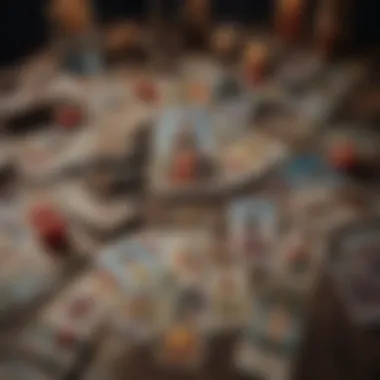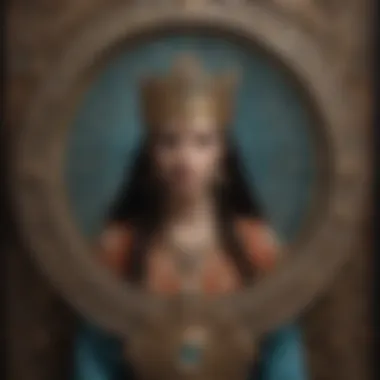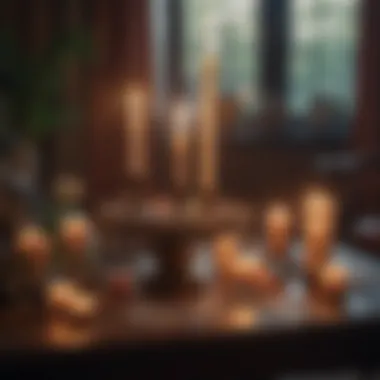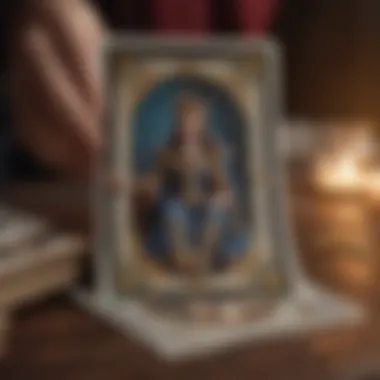Understanding Tarot Readings: A Comprehensive Guide


Intro
Tarot readings have captivated individuals for centuries, providing insights into personal issues, decision-making, and the broader human experience. This comprehensive exploration offers an in-depth understanding of tarot, from its historical roots to its modern significance. By dissecting the components of a tarot deck and the mechanics of tarot readings, we can better appreciate its psychological and spiritual dimensions.
As we delve deeper into this subject, our aim is to demystify tarot cards, examine popular spreads, and understand the interpretations that emerge. Moreover, we will reflect on how tarot can serve as a tool for personal development and introspection.
Understanding tarot requires a balanced view—recognizing both its mystical allure and its practical applications in everyday life. Whether a novice or an experienced reader, knowledge of tarot creates pathways to deeper insight.
"Tarot is not about predicting the future. It’s about understanding the present and gaining clarity about past experiences."
The subsequent sections will build on these themes, weaving together historical knowledge, practical advice, and relevant psychological insights.
Prelude to Tarot Readings
Tarot readings have attracted attention for centuries, often surrounded by both fascination and skepticism. This section lays the foundation for understanding the depth and complexity of tarot as a practice. It explores key components, distinct methodologies, and the cultural significance associated with tarot readings, allowing readers to appreciate why they continue to endure in various spiritual and psychological contexts. By grasping the essence of tarot readings, one can unlock personal insights and explore life's intricacies, particularly in areas like decision-making, self-discovery, and emotional navigation.
Defining Tarot Reading
Tarot reading refers to a practice where individuals use a deck of tarot cards to gain insight into their lives or circumstances. The process typically involves a reader who interprets the cards based on their positions and meanings. Each card holds unique symbolism and implications, representing various aspects of human experience, emotions, and situations.
The act of reading tarot is not merely about predicting future events; it offers reflections and guidance. Many practitioners believe that tarot serves as a mirror, revealing unconscious thoughts and feelings that may inform one’s path forward. As such, understanding what tarot reading encompasses is essential for those wishing to engage more deeply with its practice.
Historical Context
The roots of tarot reading can be traced back to the 15th century. Initially, tarot cards were created for playing games rather than for divination. The tarot deck evolved over time. In the 18th century, scholars began linking the tarot to various mystical and esoteric traditions, including Kabbalah and alchemy.
Interestingly, the earliest known tarot decks were produced in Italy. The Visconti-Sforza deck, for instance, encapsulates the artistry and cultural values of its time. As tarot gained traction across Europe, it became associated with fortune-telling and spiritual practices. This evolution reflected broader societal interests in mysticism and the human condition, enhancing the allure of tarot readings in contemporary times. Today, tarot is widely embraced both as a tool for spiritual insight and as an artistic tradition.
The Tarot Deck Explained
The tarot deck is the foundational tool used in tarot readings, and understanding its structure and components is essential for anyone engaging with this practice. The tarot deck consists of a unique set of cards that holds not only aesthetic value but also deep symbolic meanings that can offer insights into personal situations and life challenges. Grasping the significance of each card can enhance one's ability to interpret readings accurately, making the understanding of the tarot deck a crucial aspect of tarot practice.
Structure of the Deck
A typical tarot deck contains 78 cards, divided into two main categories: the Major Arcana and the Minor Arcana. Each category serves a distinct purpose in readings and contributes different aspects of insight.
- Major Arcana: This portion consists of 22 cards, numbered 0 to 21, and represents significant life events or spiritual lessons. Cards like The Fool, The High Priestess, and Death address major themes that have a profound influence on an individual's journey. The Major Arcana reflects the universal experiences all humans face.
- Minor Arcana: Comprising 56 cards, the Minor Arcana is further divided into four suits: Cups, Pentacles, Swords, and Wands. Each suit covers different areas of daily life. For instance, Cups focus on emotions and relationships, while Pentacles relate to material aspects and work. The Minor Arcana cards helps to provide details and context for the broader strokes painted by the Major Arcana.
Overall, the structure of the deck is more than just a collection of cards; it is a carefully curated system, serving as a guide for exploration and understanding.
Major Arcana vs. Minor Arcana
The distinction between the Major and Minor Arcana is pivotal in interpreting a tarot reading. While both types contribute valuable insight, their emphasis differs significantly.
The Major Arcana cards are often seen as indicators of life-altering events or core lessons that will shape an individual's life path. For example, drawing The Hermit may suggest a period of introspection and personal discovery. In contrast, the Minor Arcana cards generally capture the more mundane, daily occurrences and emotional states. If a reader draws the Three of Cups, it might indicate a time of celebration and connection with friends.
This differentiation allows readers to assess the weight of the messages conveyed. Major Arcana cards often signal pivotal moments or profound insights, while Minor Arcana cards flesh out the nuances of one’s current circumstances.
Card Symbolism and Imagery
The symbolism and imagery within tarot cards are another crucial layer of meaning. Each card is filled with symbols that can evoke specific interpretations and feelings. Understanding these symbols can dramatically influence the insights a reader can provide.
For instance, the image of a lion on the Strength card symbolizes courage and bravery. In a reading, this could represent encouragement to face one's fears. Similarly, the imagery on The Star often exudes hope and renewal, prompting reflection on one's aspirations.


Each detail in the artwork—from colors to characters—presents layers of meaning that resonate differently depending on the context of the reading. Additionally, as interpretations can vary widely between different tarot traditions, readers may find that exploring multiple decks enriches their understanding.
Methods of Conducting a Tarot Reading
The methods of conducting a tarot reading are fundamental in structuring the reading itself. This section explores the various elements, benefits, and considerations that can influence the outcome of a tarot reading. Understanding these methods aids both the seeker and the reader in navigating the complexities of tarot, which enhances the overall experience.
Choosing a Tarot Spread
Choosing a tarot spread is a pivotal step in the tarot reading process. This spread refers to the arrangement of cards during a reading and significantly shapes how the cards communicate their messages. Different spreads can be used for various purposes, such as gaining insights into past events, understanding present challenges, or forecasting future possibilities.
Here are some common types of spreads:
- Single Card Spread: Ideal for quick, focused questions.
- Three Card Spread: Often used to explore past, present, and future.
- Celtic Cross Spread: Offers a comprehensive view of a situation, examining ten different aspects.
- Relationship Spread: Focuses on the dynamics between two individuals.
Each spread serves a distinct purpose, tailoring the reading to the seeker’s needs. The choice of spread depends significantly on what the seeker wishes to understand, making it a critical consideration in the overall reading experience.
Shuffling and Drawing Cards
Shuffling and drawing cards may seem straightforward, but these actions hold significant importance in tarot readings. Shuffling not only randomizes the cards but also allows the energy of the seeker to intermingle with the deck, which can enhance the accuracy of the reading. This is often seen as a way to imprint one’s intentions on the cards.
When drawing cards, there are various methods. Some readers allow seekers to draw their own cards, creating a sense of agency. Others may draw cards on behalf of the seeker. The method can influence the connection the seeker feels with the reading. Regardless of the approach, it is crucial that the ambient environment is calm and focused to promote clarity.
Position Meanings in Spread
The position of each card within a spread is integral to interpreting its meaning. Each position has a designated significance that relates to the seeker’s questions or concerns. For instance, in the Celtic Cross, the first card typically represents the present situation, while subsequent cards may indicate obstacles, past influences, and future outcomes.
Understanding the relationship between card positions and their meanings is essential. For example:
- Past Position: Offers insight into influences that have shaped the current narrative.
- Present Position: Reflects the current state of affairs.
- Future Position: Points to potential outcomes based on current paths.
A clear grasp of position meanings aids in weaving together the narrative woven by the cards. By considering the positions alongside individual card meanings, a reader can deliver a multifaceted and illuminating message to the seeker.
The effectiveness of a tarot reading is not just in the cards drawn but in the thoughtful methods employed to interpret them.
Interpreting the Cards
Interpreting the cards is a fundamental aspect of tarot readings. It involves understanding the meanings behind each card and how they relate to one another. This process not only illuminates the situation at hand but also encourages introspection and personal growth. Each card has its unique significance and resonates differently in various contexts, making the art of interpretation both challenging and rewarding.
Focusing on interpretation provides benefits such as enhancing clarity in decision-making and promoting emotional awareness. With the right approach, individuals can gain valuable insights about their relationships, career path, or personal challenges. Thus, effective card interpretation is crucial for obtaining meaningful results from a tarot reading.
Reading Major Arcana Cards
Major Arcana cards hold substantial weight in a tarot spread. They typically represent significant life events, spiritual lessons, or deep psychological themes. Each card in this set tells a story that might denote pivotal moments in one's life journey.
Examples include:
- The Fool: Symbolizing new beginnings and spontaneity.
- The Tower: Signifying chaos that leads to transformation.
- The Lovers: Reflecting relationships and choices.
When reading Major Arcana cards, consider their position in the spread and the surrounding cards. This context enhances the interpretation, revealing nuances that are often tied to personal history or current life situations.
Reading Minor Arcana Cards
Minor Arcana cards provide insights into the everyday aspects of life. They focus on situations, challenges, and influences that shape daily experiences. This subset is divided into four suits: Cups, Pentacles, Swords, and Wands, each associated with different themes.
For instance:


- Cups often relate to emotions and relationships.
- Swords might indicate conflicts or challenges.
- Wands resonate with actions and ambitions.
- Pentacles tend to represent material aspects, such as financial stability.
Understanding the Minor Arcana involves recognizing how these cards reflect daily issues and how they interconnect with Major Arcana lessons. Paying attention to the energy and emotions involved is important for a comprehensive reading.
Common Interpretive Techniques
There are several techniques one can employ when interpreting tarot cards. Familiarizing yourself with these can deepen understanding during readings.
- Intuitive Approach: Trusting your instincts about what a card represents. Focus on your feelings and thoughts during the reading.
- Numerology: Each number associated with a card may carry specific meanings that can enhance interpretation.
- Reversals: Cards drawn in reverse can alter their meaning, suggesting blockages or challenges.
- Patters: Assessing the relationships between cards in a spread can reveal deeper messages or themes.
Psychological Aspects of Tarot Readings
Tarot readings are often associated with spiritual insight, but their psychological aspects are just as significant. This section explores how engaging with tarot can influence self-perception and decision-making. Understanding tarot from a psychological perspective can provide individuals with tools for introspection and personal development. The process of interpreting tarot cards taps into deeper emotional responses and can reveal underlying thoughts and feelings that may not be immediately apparent.
Tarot and Self-Reflection
Self-reflection is a core element of tarot readings. When individuals engage with a tarot reading, they often use it as a moment to pause and reflect on their current situation. The cards serve as prompts to explore one's thoughts and emotions. For example, drawing the Two of Swords might encourage a person to consider the decisions they are avoiding. This moment of reflection can lead to greater clarity about personal circumstances.
Moreover, as individuals articulate their thoughts during a reading, they often gain new perspectives. This process can reveal conflicts or challenges that may not have been consciously recognized. The conversation around essential questions during a reading can guide introspection and lead to insights about personal goals or fears.
The Role of Intuition
Intuition plays a crucial role in the tarot reading process. Readers draw upon their intuitive skills to interpret the meanings behind the drawn cards. This intuitive aspect can be beneficial for both the reader and the querent (the person receiving the reading). Intuition helps readers connect the symbolic meanings of the cards to the specific context of the inquiry.
Importantly, intuition is not solely limited to the reader. Individuals receiving a tarot reading are also encouraged to listen to their own instincts. When a person recognizes their intuitive responses to the cards, they may uncover personal truths that resonate with their experiences. This practice helps to bridge the gap between thought and feeling, making the tarot reading a more holistic experience.
"Tarot readings foster an environment where individuals can engage with their intuitive capacities, leading to insights that would otherwise remain dormant."
In summary, the psychological dimensions of tarot readings offer pathways for self-discovery and growth. By promoting self-reflection and enhancing intuition, tarot proves to be a valuable tool in understanding one’s inner landscape.
The Reader's Perspective
In the context of tarot reading, the perspective of the reader plays a crucial role in the effectiveness and relevance of the reading itself. Understanding how a reader approaches the practice gives insight into the nuances that can either enhance or detract from the experience. A skilled reader is not just an interpreter of the cards; they become a mediator between symbols and the querent's personal journey. The reader’s demeanor, interpretations, and intuitions shape the outcome of the session significantly.
Qualities of an Effective Reader
An effective tarot reader embodies specific qualities that are essential for a productive session. These attributes include:
- Intuition: The ability to trust one's gut feelings can lead to profound insights during readings. Intuition allows a reader to interpret card meanings in context with the querent's life.
- Empathy: An understanding and compassionate approach contribute to creating a safe environment for the querent. Empathy helps readers to connect deeply with the person's experiences and emotions.
- Knowledge: Knowledge of tarot card meanings, spreads, and symbolisms is fundamental. An informed reader can provide clarity that arises from understanding the complexities of the cards.
- Communication Skills: The ability to articulate ideas clearly and sensitively matters. Effective communication ensures that the querent understands the insights shared without misinterpretation.
These qualities synergize to form a strong foundation for successful tarot readings. As much as the cards convey their messages, the reader's qualities help in delivering those messages in a meaningful way.
Ethics in Tarot Reading
The ethical considerations in tarot reading cannot be overstated. The responsibility of interpreting sensitive information weighs heavily on a reader. Key ethical points include:
- Confidentiality: Protecting the private information shared by clients is of utmost importance. A reader should create a safe space where querents feel comfortable to open up.
- Honesty: Transparency about the nature of tarot readings, including the fact that it should not be seen as a definitive prediction, is crucial. Readers must make clear that the cards offer guidance rather than concrete outcomes.
- Avoiding Dependence: Effective readers should encourage querents to make their own choices and decisions, rather than instilling a sense of dependency on tarot readings for answers.
- Respect for Beliefs: Acknowledging and respecting the varying beliefs and backgrounds of querents fosters a positive environment. Readers should approach sessions without bias or judgment.
"The ethics of tarot reading not only protect clients but also elevate the practice itself, ensuring a respectful and mindful approach to personal exploration."
Engaging with these ethical aspects of tarot reading not only reassures the querent but also enhances the credibility of the field as a whole. Readers who prioritize ethics can cultivate trust and foster meaningful connections with those seeking guidance.
Personal Growth and Tarot
The intersection between tarot and personal growth is profound. Tarot readings serve not only as a tool for divination but also as a means for self-exploration. Engaging with tarot can promote a deeper understanding of oneself and the world around, leading to significant personal development.


Through the lens of tarot, individuals can confront their inner thoughts and feelings. Each card symbolizes various aspects of life, encouraging reflection and contemplation. By consistently using tarot, one may identify patterns in behavior and thought processes that may otherwise remain unchecked. This practice can illuminate challenges and help chart a path toward improvement.
Using Tarot for Problem-Solving
Tarot can be particularly beneficial in approaching problems. When faced with a dilemma, drawing cards can provide perspective and clarity. The act of interpreting the cards requires one to consider multiple viewpoints and options. This mental exercise can help break down complex issues into manageable pieces.
For example:
- Identify the Problem: Rather than jumping to conclusions, a reader can align a question with specific cards drawn.
- Explore Emotions: The cards may reflect underlying emotions related to the issue, fostering deeper insights.
- Consider Outcomes: By examining the implications of different cards, a person can weigh potential solutions.
Using tarot in this way blends intuition with analysis, turning the reading into a problem-solving strategy.
Integration of Tarot into Daily Life
To gain the full benefits of tarot, integration into daily life is essential. This does not require lengthy sessions; rather, it can be as simple as pulling a card each morning for guidance. This practice allows individuals to start their day with intention and focus.
- Daily Draws: Set aside a moment daily for a single card pull. Reflect on its meaning in light of upcoming events.
- Journaling: Write down thoughts and feelings associated with the card drawn. This can capture mood shifts and help track personal growth.
- Meditation: Incorporate tarot imagery into meditation practices. This can encourage deeper connections to personal insights.
Incorporating tarot into routine can foster a conscious approach to daily challenges. It allows for ongoing learning and self-discovery, enhancing the path toward personal growth.
Debunking Myths About Tarot
Understanding the common myths surrounding tarot is crucial for grasping its true essence. Many people view tarot through a lens of superstition or skepticism, believing it to be solely for fortune-telling. This perception often limits the understanding of tarot as a complex tool for self-reflection and personal development. By debunking these myths, we can appreciate tarot's deeper significance in both spiritual and psychological contexts. Here, we will explore prevalent misconceptions and clarify the distinctions that exist within tarot practices.
Common Misconceptions
A wide array of misconceptions exists regarding tarot. Some of the most common include:
- Tarot is purely for predicting the future: Many believe that tarot reading is strictly about foreseeing future events. In reality, it is more about guidance. Readers consider the cards as reflections of the present situation, allowing clients to make informed decisions rather than simply predicting what will happen.
- Tarot is linked to the occult or witchcraft: While tarot has historical ties to various mystical traditions, many practitioners use it as a form of meditation or self-exploration. This is far removed from any sinister connotations.
- Tarot readings are accurate for everyone: Another myth is the idea that tarot readings will yield accurate results universally. The effectiveness of a reading often depends on the reader's intuition, the connection with the querent, and the context of the questions asked.
- Only "psychics" can read tarot: While some readers may claim psychic abilities, tarot can be approached by anyone willing to learn. Many practitioners rely on their knowledge of card meanings and spreads, rather than supernatural abilities.
As we dismantle these myths, it becomes evident that tarot is about personal agency and insight.
Understanding Predictions vs. Guidance
One of the most significant differences in tarot practice is the distinction between predictions and guidance. This aspect is vital in understanding how to approach tarot reading.
- Predictions are often viewed as statements about future events that imply determinism. Individuals might expect a tarot reading to deliver a fixed outcome. However, such expectations overlook the essential premise of free will and personal choice in shaping one's path.
- Guidance, on the other hand, emphasizes the interpretive nature of tarot. It illustrates potential outcomes based on current circumstances. A reading can highlight themes and challenges present in a person's life, encouraging them to reflect and make conscious choices. This could inspire action towards positive change or awareness of existing patterns.
The clarity between predictions and guidance enables individuals to utilize tarot as a means of empowerment.
The End: The Relevance of Tarot Today
The significance of tarot readings has evolved over the years, adapting to the changing perceptions and needs of society. Today, tarot is not merely viewed as a tool for fortune-telling; it is increasingly respected as a method for self-discovery, guidance, and personal reflection. Many individuals seek tarot readings not only for insight into future events but also for understanding their current circumstances more deeply.
The Future of Tarot Readings
As society continues to navigate complexities in life, the appeal of tarot readings is likely to grow. The ongoing dialogue around mental health, spirituality, and self-help underlines the relevance of tarot as a valid practice in personal development. More people are turning to tarot in the context of mindfulness, therapy, and holistic well-being.
Some potential trends for the future include:
- Integration with technology: Digital platforms for tarot readings are emerging, providing convenience and accessibility. Mobile apps and online services allow users to engage with tarot in a format that suits their lifestyle.
- Diverse perspectives: With a greater emphasis on inclusivity, varied cultural interpretations of tarot are likely to gain prominence. This could lead to an enrichment of traditional practices, making tarot a more universal tool of self-exploration.
- Educational initiatives: As interest in tarot continues, workshops and courses can promote understanding and responsible use. This may foster a more informed community, enhancing the perceived legitimacy of tarot as a practice.
Final Thoughts on Personal Interpretation
Ultimately, the power of tarot lies in personal interpretation. Each reading presents a unique narrative shaped by the reader's intuition and the querent's context. Individuals are encouraged to embrace personal insights gained through tarot, using them as a compass in their decision-making process.
The relationship between tarot and personal interpretation emphasizes the following:
- Empowerment: Individuals often find a sense of agency in interpreting cards. This empowerment can aid in clarifying thoughts and feelings.
- Subjectivity: Tarot is inherently subjective. Different readers may offer varied interpretations based on their experiences and biases. Understanding this can inspire growth and reflection.
- Flexibility: Readings may resonate differently at various times. As personal circumstances change, so too can the meanings derived from a reading, highlighting the dynamic nature of tarot.
In summary, tarot is not merely an esoteric practice; it has become a meaningful tool for those seeking deeper understanding and connection with themselves. Its relevance today stems from its ability to adapt, resonate, and provide insights that are personal yet universal.



